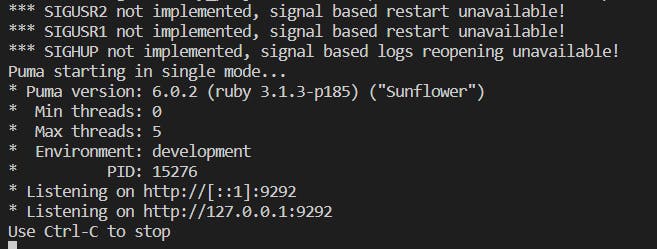How to Build a Server with Hanami::API and Postgres
 Carlos Armando Marcano Vargas
Carlos Armando Marcano Vargas
DISCLAIMER: This is a basic article about Hanami::API, showing how to perform CRUD operations using Postgres through PG driver. I'm writing this article to continue learning about Ruby so probably my code is not idiomatic.
Hanami-API is a lightweight and fast Ruby framework for building HTTP APIs. It is a part of the Hanami web framework, which is made up of smaller, single-purpose libraries that can be used independently or together in a Hanami application. The framework provides a simple and effective way to build and deploy HTTP APIs in Ruby, allowing developers to create endpoints with different HTTP methods, extract parameters from the URI, and parse the payload of incoming requests. In this article, we will explore how to get started with Hanami-API by creating endpoints for a simple to-do list application.
Hanami
Hanami is a full-stack Ruby web framework. It's made up of smaller, single-purpose libraries.
Hanami is made of the following libraries:
Hanami::Router - Rack-compatible HTTP router for Ruby
Hanami::Controller - Full-featured, fast and testable actions for Rack
Hanami::View - Presentation with a separation between views and templates
Hanami::Helpers - View helpers for Ruby applications
Hanami::Mailer - Mail for Ruby applications
Hanami::Assets - Assets management for Ruby
According to its README, these components are designed to be used independently or together in a Hanami application.
Hanami::API
It's a minimal, extremely fast, lightweight Ruby framework for HTTP APIs.
PG driver
Pg is the Ruby interface to the Postgres RDBMS. It works with Postgres 9.3 or later.
Requirements
- Ruby 3.0+ installed.
Installation
First, we create a folder for our project. And in it, we create two files, gemfile and config.ru.
Inside gemfile file, we write the following lines:
gem "hanami-api"
gem "puma"
Then, inside config.ru, we write the following code:
# frozen_string_literal: true
require "bundler/setup"
require "hanami/api"
class App < Hanami::API
get "/" do
"Hello, world"
end
end
run App.new
Then, we run bundle exec rackup in the command line.

Creating the application
We create a new file, app.rb, to write all our endpoints.
We will have 5 endpoints.
class App < Hanami::API
list_tasks = [
{"id": 1, "title": "Buy almonds"},
{"id": 2, "title": "Buy Nuts"}
]
get "/" do
"Hello, world"
end
get "/tasks" do
json list_tasks
end
In app.rb file, we create the App class. In this class, we will put all our endpoints. We create an array with 2 hashmaps with items to buy.
We define a GET endpoint with the URI /tasks. This endpoint will show all the elements in the array. We use the json method to send the response in JSON format.
We have to make a few changes in the config.ru file. We replace the App class with require_relative 'app'.
require "bundler/setup"
require "hanami/api"
require "hanami/middleware/body_parser"
require_relative 'app'
run App.new
Now, we run bundle exec rackup .
Database
database.rb
We create a database.rb file, to initialize the database and write the controllers to perform CRUD operations.
require "pg"
class Database
DB_HOST = 'localhost'
DB_PORT = 5432
DB_NAME = 'hanami_db'
DB_USER = '<USER>'
DB_PASSWORD = '<PASSWORD>'
def initialize(db_name:DB_NAME, user: DB_USER, password:DB_PASSWORD, host: 'localhost', port: 5432)
@conn = PG.connect(dbname: db_name, user: user, password: password, host: host, port: port)
end
def close
@conn.close
end
end
In this code snippet we define several constants DB_HOST, DB_PORT, DB_NAME, DB_USER, and DB_PASSWORD to store the details of the database connection.
This class has an initialize method that accepts several arguments for database db_name, user, password, host, and port. It sets instance variable @conn using the PG.connect method call with the provided values for db_name, user, password, host, and port.
The PG.connect method call seems to be using the pg gem which is a PostgreSQL client for Ruby
The close method is defined to close the @conn object.
Create a record
def create_records(params)
sql = "INSERT INTO records (name, profession) VALUES ($1, $2) RETURNING *"
result = @conn.exec(sql, params)
return result
end
The create_records expects a parameter params to be passed into it. To perform an insert the data passed into the records table.
The sql variable is a string containing an SQL statement that specifies the insertion query. It contains placeholders $1 and $2 for the values of the name and profession of the new record to be inserted.
The method then calls the exec method on the instance variable @conn, passing in the sql variable and params as arguments. The exec method is used to execute an SQL query through the open database connection using the provided params.
Retrieve all the records
def all_records
sql = "SELECT id, name, profession FROM records"
result = @conn.exec(sql)
return result
end
This method performs a selection query on a records table to return all records.
The sql variable is a string containing an SQL statement that selects all columns from the records table.
The method then calls the exec method on the instance variable @conn, passing in the sql variable as an argument. The exec method is used to execute an SQL query through the open database connection.
Retrieve a record
def get_record(params)
sql = "SELECT * FROM records WHERE id = $1"
result = @conn.exec(sql, params)
return result
end
The method get_record expects a single parameter to be passed into it. The parameter is a value to be inserted into the id column in the records table.
The method first creates an SQL statement that selects all columns from the records table where the id column equals the passed parameter value. The sql variable is a string that includes a parameter placeholder, $1, which is a reference to the first parameter passed into the method.
The method then calls the exec method on the instance variable @conn, passing in both the sql variable and the params variable as arguments. The exec function replaces the $1 placeholder in the SQL string with the value of the params variable.
The result of the query execution is then stored in the result variable.
Update a record
def update_record(params)
sql = "UPDATE records SET name=$2, profession=$3 WHERE id=$1 RETURNING *"
result = @conn.exec(sql, params)
return result
end
The method constructs an SQL statement that updates the name and profession columns of the records table for the row where the id column equals the first parameter passed to the method. The new values for the name and profession columns are the 2nd and 3rd parameters passed to the method. The RETURNING clause at the end of the SQL statement specifies that the updated row should be returned as the result of the query.
The sql variable is then passed to the exec method on the @conn object, along with the params parameter, which is an array containing the values for the parameters referenced in the SQL statement. The exec method executes the SQL statement against the database and returns the result as an array of rows.
Finally, the method assigns the array returned by exec to the result variable.
Delete a record
def delete_record(params)
sql = "DELETE FROM records WHERE id=$1"
result = @conn.exec(sql, params)
return result
end
This looks like a Ruby method named delete_record that accepts a single parameter params.
The method constructs an SQL statement that deletes a row from the records table where the id column equals the first parameter passed to the method.
The sql variable is then passed to the exec method on the @conn object, along with the params parameter, which is an array containing the value for the parameter referenced in the SQL statement. The exec method executes the SQL statement against the database and returns the result as an array of rows.
Finally, the method explicitly returns the result variable, which should be an array containing information about the success/failure of the delete operation.
So, this is a method to delete a row from the records table based on the given id.
Complete database.rb file
require "pg"
class Database
DB_HOST = 'localhost'
DB_PORT = 5432
DB_NAME = 'hanami_db'
DB_USER = '<USER>'
DB_PASSWORD = '<PASSWORD>'
def initialize(db_name:DB_NAME, user: DB_USER, password:DB_PASSWORD, host: 'localhost', port: 5432)
@conn = PG.connect(dbname: db_name, user: user, password: password, host: host, port: port)
end
def create_records(params)
sql = "INSERT INTO records (name, profession) VALUES ($1, $2) RETURNING *"
result = @conn.exec(sql, params)
end
def all_records
sql = "SELECT id, name, profession FROM records"
result = @conn.exec(sql)
return result
end
def get_record(params)
sql = "SELECT * FROM records WHERE id = $1"
result = @conn.exec(sql, params)
return result
@conn.close
end
def update_record(params)
sql = "UPDATE records SET name=$2, profession=$3 WHERE id=$1 RETURNING id, name, profession"
result = @conn.exec(sql, params)
end
def delete_record(params)
sql = "DELETE FROM records WHERE id=$1"
result = @conn.exec(sql, params)
end
def close
@conn.close
end
end
Endpoints
app.rb
class App < Hanami::API
use Hanami::Middleware::BodyParser, :json
#endpoints here
end
Here we initialize the App class and specifies that we will be using the Hanami::API module. The use statement adds a middleware to our endpoint to parse JSON bodies, making it possible to extract data from incoming JSON requests with ease.
POST Request
post '/records' do
db = Database.new
new_record = db.create_records([params[:name], params[:profession]])
db.close
json new_record.first.to_h
end
The POST endpoint expects incoming requests to have a name and profession parameter in their body. It create a new instance of the database, then creates a new record in the database using the create_records method, passing in an array containing the name and profession parameters. This method returns a collection of created records, and the code selects the first record from this collection and converts it to a hash before returning it as JSON.
The db.close statement is closing the connection to the database.
GET Requests
# Get all records
get '/records' do
db = Database.new
result = db.all_records
db.close
json result.map { |record| { id: record['id'], name: record['name'], profession: record['profession'] } }
end
# Get a record by its id
get '/records/:id' do
db = Database.new
result = db.get_record([params[:id]])
if result.ntuples.zero?
db.close
json ({status: status(404), message: "Entry #{params[:id]} not found"})
else
db.close
json result.first.to_h
end
end
The /records endpoint retrieves all records and returns the data as a JSON response. It first creates a new instance of the Database class, calls the all_records method to retrieve all records, then closes the connection to the database. After that, it maps the records returned into a new array containing only the relevant fields, such as id, name, and profession, before rendering it as a JSON response.
The /records/:id endpoint retrieves a single record with the specified ID. This piece of code creates a new instance of the Database class, then it calls the get_record method, passing in the id parameter from the URL. If the query returns no records, the code returns an error message as a JSON response with a 404 status. If the query returns a record, the code converts it to a hash and returns it as a JSON response.
PUT Request
put '/records/:id' do
db = Database.new
record = db.get_record([params[:id]])
if record.ntuples.zero?
db.close
json ({status: status(404), message: "Entry #{params[:id]} not found"})
else
result = db.update_record([params[:id], params[:name], params[:profession]])
db.close
json result.first.to_h
end
end
This endpoint updates a single record with the specified ID. We create a new instance of the Database class, then calls the get_record method, passing in the id parameter from the URL. If the query returns no records, the code returns an error message as a JSON response with a 404 status.
If the query returns a record, the code proceeds to update it with information from the HTTP request body.
DELETE Request
delete '/records/:id' do
db = Database.new
record = db.get_record([params[:id]])
if record.ntuples.zero?
db.close
json ({status: status(404), message: "Entry #{params[:id]} not found"})
else
db.delete_record([params[:id]])
db.close
json "Records deleted"
end
end
This endpoint deletes a single record with the specified ID. Again, we start by creating a new instance of the Database class, then calls the get_record method, passing in the id parameter from the URL. If the query returns no records, the code returns an error message as a JSON response with a 404 status.
If the query returns a record, the code proceeds to delete it by calling the delete_record method with an array containing the id parameter that it received as part of the HTTP request.
Complete app.rb file
require_relative 'database'
class App < Hanami::API
use Hanami::Middleware::BodyParser, :json
# Create a new record
post '/records' do
db = Database.new
new_record = db.create_records([params[:name], params[:profession]])
db.close
json new_record.first.to_h
end
# Get all records
get '/records' do
db = Database.new
result = db.all_records
db.close
json result.map { |record| { id: record['id'], name: record['name'], profession: record['profession'] } }
end
# Get a record by its id
get '/records/:id' do
db = Database.new
result = db.get_record([params[:id]])
if result.ntuples.zero?
db.close
json ({status: status(404), message: "Entry #{params[:id]} not found"})
else
db.close
json result.first.to_h
end
end
# Update a record
put '/records/:id' do
db = Database.new
record = db.get_record([params[:id]])
if record.ntuples.zero?
db.close
json ({status: status(404), message: "Entry #{params[:id]} not found"})
else
result = db.update_record([params[:id], params[:name], params[:profession]])
db.close
json result.first.to_h
end
end
# Delete a record
delete '/records/:id' do
db = Database.new
record = db.get_record([params[:id]])
if record.ntuples.zero?
db.close
json ({status: status(404), message: "Entry #{params[:id]} not found"})
else
db.delete_record([params[:id]])
db.close
json "Records deleted"
end
end
end
Conclusion
I'm continuing to learn about Ruby and Hanami. In this article, I add a database using PG Driver. I have an issue trying to implement the database operations, especially related to closing the pool after every query. I just want to initialize the database and close the pool when an operation is finished, but when another operation started, the pool was already closed.
The alternative that I found to solve this issue was to initialize a new instance of a database in every operation. I didn't try to use this alternative in the controllers, I don't if it would be more appropriate. Please level your thoughts about it or if you have any solution.
Thank you for taking the time to read this article.
If you have any recommendations about other packages, architectures, how to improve my code, my English, or anything; please leave a comment or contact me through Twitter, or LinkedIn.
The source code is here.
Resources
Subscribe to my newsletter
Read articles from Carlos Armando Marcano Vargas directly inside your inbox. Subscribe to the newsletter, and don't miss out.
Written by

Carlos Armando Marcano Vargas
Carlos Armando Marcano Vargas
I am a backend developer from Venezuela. I enjoy writing tutorials for open source projects I using and find interesting. Mostly I write tutorials about Python, Go, and Rust.